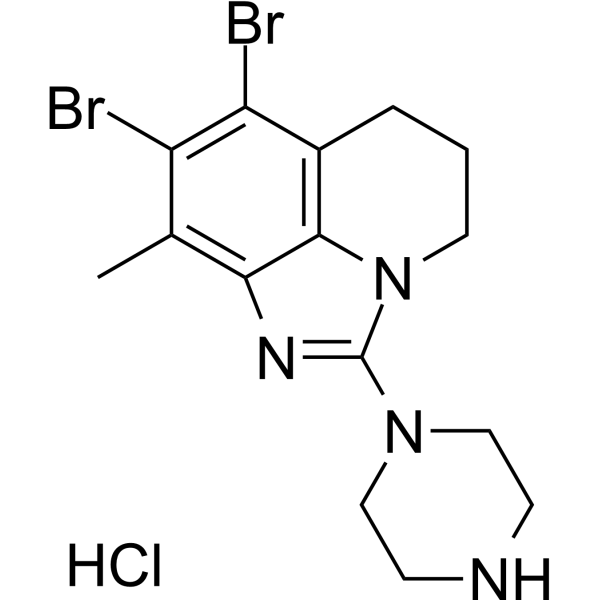Physicochemical Properties
| Molecular Formula | C15H19BR2CLN4 |
| Molecular Weight | 450.599160432816 |
| Exact Mass | 449.964 |
| CAS # | 2443816-41-7 |
| Related CAS # | SEL120-34A HCl;1609452-30-3;SEL120-34A;1609522-33-9 |
| PubChem CID | 73776232 |
| Appearance | White to off-white solid powder |
| Hydrogen Bond Donor Count | 2 |
| Hydrogen Bond Acceptor Count | 3 |
| Rotatable Bond Count | 1 |
| Heavy Atom Count | 22 |
| Complexity | 390 |
| Defined Atom Stereocenter Count | 0 |
| InChi Key | GQXLWUCQESKBSC-UHFFFAOYSA-N |
| InChi Code | InChI=1S/C15H18Br2N4.ClH/c1-9-11(16)12(17)10-3-2-6-21-14(10)13(9)19-15(21)20-7-4-18-5-8-20;/h18H,2-8H2,1H3;1H |
| Chemical Name | 6,7-dibromo-5-methyl-2-piperazin-1-yl-1,3-diazatricyclo[6.3.1.04,12]dodeca-2,4,6,8(12)-tetraene;hydrochloride |
| HS Tariff Code | 2934.99.9001 |
| Storage |
Powder-20°C 3 years 4°C 2 years In solvent -80°C 6 months -20°C 1 month Note: Please store this product in a sealed and protected environment, avoid exposure to moisture. |
| Shipping Condition | Room temperature (This product is stable at ambient temperature for a few days during ordinary shipping and time spent in Customs) |
Biological Activity
| Targets | CDK8/CycC 4.4 nM (IC50) CDK19/CycC 10.4 nM (IC50) CDK9/cycT 1070 nM (IC50) |
| ln Vitro | SEL120-34A monohydrochloride is an ATP-competitive, selective CDK8 inhibitor that inhibits the kinase activities of CDK8/CycC and CDK19/CycC complexes. Its Kd for CDK8 is 3 nM, and its IC50s are 4.4 nM and 10.4 nM, respectively. Although SEL120-34A monohydrochloride has no discernible activity against CDK1, 2, 4, 6, 5, 7, it slightly inhibits CDK9 (IC50=1070 nM)[1]. SEL120-34A (1.6 nM-5 μM) is not harmful to S726 negative MOLM13 AML cells, however it suppresses the development of STAT5 S726 positive KG-1 AML cells[1]. The phosphorylation of STAT1 S727 and STAT5 S726 is inhibited by SEL120-34A monohydrochloride, which also reduces the expression of IRF9 and STAT1 mRNA and mitogen-induced IER[1]. |
| ln Vivo | SEL120-34A monohydrochloride (30, 60 mg/kg, po once a day) suppresses growth of AML tumors in a dose-dependent manner in SCID mice after treatment for 17 days[1]. |
| References |
[1]. SEL120-34A is a novel CDK8 inhibitor active in AML cells with high levels of serine phosphorylation of STAT1 and STAT5 transactivation domains. Oncotarget. 2017 May 16;8(20):33779-33795. |
| Additional Infomation | CDK8/19 Inhibitor RVU120 is an orally bioavailable inhibitor of cyclin-dependent kinases 8 and 19 (CDK8/19), with potential antineoplastic and chemoprotective activities. Upon oral administration, CDK8/19 inhibitor RVU120 targets, binds to and inhibits the activity of CDK8/19, which prevents activation of CDK8/19-mediated oncogenic signaling pathways, blocks selective transcription of various tumor-promoting genes, and inhibits proliferation of CDK8/19-overexpressing tumor cells. CDK8/19, serine/threonine kinases involved in the regulation of the cell cycle, are overexpressed in certain cancer cell types and play key roles in tumor cell proliferation. |
Solubility Data
| Solubility (In Vitro) |
H2O : 50 mg/mL (110.96 mM) DMSO : 16.67 mg/mL (37.00 mM) |
| Solubility (In Vivo) |
Solubility in Formulation 1: ≥ 1.67 mg/mL (3.71 mM) (saturation unknown) in 10% DMSO + 40% PEG300 + 5% Tween80 + 45% Saline (add these co-solvents sequentially from left to right, and one by one), clear solution. For example, if 1 mL of working solution is to be prepared, you can add 100 μL of 16.7 mg/mL clear DMSO stock solution to 400 μL PEG300 and mix evenly; then add 50 μL Tween-80 to the above solution and mix evenly; then add 450 μL normal saline to adjust the volume to 1 mL. Preparation of saline: Dissolve 0.9 g of sodium chloride in 100 mL ddH₂ O to obtain a clear solution. Solubility in Formulation 2: ≥ 1.67 mg/mL (3.71 mM) (saturation unknown) in 10% DMSO + 90% (20% SBE-β-CD in Saline) (add these co-solvents sequentially from left to right, and one by one), clear solution. For example, if 1 mL of working solution is to be prepared, you can add 100 μL of 16.7 mg/mL clear DMSO stock solution to 900 μL of 20% SBE-β-CD physiological saline solution and mix evenly. Preparation of 20% SBE-β-CD in Saline (4°C,1 week): Dissolve 2 g SBE-β-CD in 10 mL saline to obtain a clear solution. Solubility in Formulation 3: ≥ 1.67 mg/mL (3.71 mM) (saturation unknown) in 10% DMSO + 90% Corn Oil (add these co-solvents sequentially from left to right, and one by one), clear solution. For example, if 1 mL of working solution is to be prepared, you can add 100 μL of 16.7 mg/mL clear DMSO stock solution to 900 μL of corn oil and mix evenly. Solubility in Formulation 4: 14.29 mg/mL (31.71 mM) in PBS (add these co-solvents sequentially from left to right, and one by one), clear solution; with ultrasonication (<60°C). (Please use freshly prepared in vivo formulations for optimal results.) |
| Preparing Stock Solutions | 1 mg | 5 mg | 10 mg | |
| 1 mM | 2.2193 mL | 11.0963 mL | 22.1926 mL | |
| 5 mM | 0.4439 mL | 2.2193 mL | 4.4385 mL | |
| 10 mM | 0.2219 mL | 1.1096 mL | 2.2193 mL |
